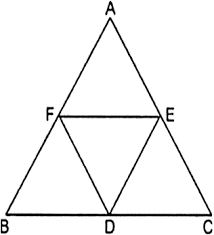

Solution :
Given in ∆ABC D, E, F are the midpoints of the sides BC, CA and AB.
In ∆ABC, EF is the line join of mid-points of two sides AB and AC of ∆ABC.
Similarly DE divides AC and BC in the same ratio, i.e., DE ∥ .
Now in □ BDEF, both pairs of opposite sides (BD ∥ EF and DE ∥ BF) are parallel.
Hence □ BDEF is a where is a diagonal.
∴ ∆ ≃ ∆ .....(1)
Similarly we can prove that
∆DEF ≃ ∆ .....(2)
[∵ CDFE is a parallelogram]
∆DEF ≃ ∆ .....(3)
[∵ □ AEDF is a parallelogram]
From (1), (2) and (3)
∆ ≃ ∆DEF ≃ ∆ ≃ ∆CDE
Also, ∆ABC = ∆ + ∆DEF + ∆ + ∆CDE = .∆
Hence, ∆ABC : ∆DEF = : .